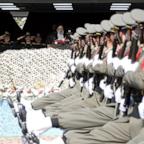Political Views Reflected in Brain Structure
Political views are tied to brain structure, study suggests.
April 7, 2011— -- Amid the looming prospect of a government shutdown, the clock is ticking for Democrats and Republicans to strike a deal. But new research suggests brain differences might make it hard for the parties to see eye to eye.
Using MRI scans, scientists at University College London found structural differences in the brains of people with liberal and conservative political views. The study was published today in Current Biology.
"Previously, some psychological traits were known to be predictive of an individual's political orientation," lead author Ryota Kanai from University College London's Institute of Cognitive Neuroscience said in a statement. "Our study now links such personality traits with specific brain structure."
Oscar-winning actor Colin Firth, who discussed the notion of the "political brain" in a BBC Radio 4 interview in January, was also an author of the study.
The researchers used a survey to probe the political views of 90 University students who later underwent brain scans. People with self-reported liberal views tended to have a larger anterior cingulate cortex -- a brain area involved in processing conflicting information. And those with conservative views were more likely to have a larger amygdala -- a region important for recognizing threats.
"Individuals with a large amygdala are more sensitive to fear," and might therefore be "more inclined to integrate conservative views into their belief system," Kanai and colleagues wrote. "On the other hand, our finding of an association between anterior cingulate cortex volume and political attitudes may be linked with tolerance to uncertainty" -- which may allow people to "accept more liberal views."
This is not the first study to link political attitudes with biological differences. A 2005 twin study revealed a role for genetics, and a 2010 study showed that genetic variations can interact with environmental factors to influence political views.
"To me it makes a lot of sense," said Dr. Marco Iacoboni, professor of psychiatry and biobehavioral sciences at UCLA and director of the Transcranial Magnetic Stimulation Lab at the Ahmanson-Lovelace Brain Mapping Center. "We have these tendencies to think our thoughts come out of nowhere, but they actually come from our biology."
Iacoboni, a liberal, has been using brain imaging to study political preferences since 2004.
"I'm glad to see liberals have a large anterior cingulate cortex -- the more sophisticated part of the brain," he said.
The amygdala, on the other hand, is a "really old structure, and not as developed."




